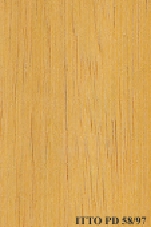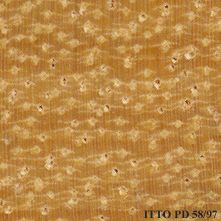
RAMIN (Gonystylus bancanus)
Trade Name
Ramin
Scientific Name
Gonystylus bancanus (Miq.) Kurz
Family
Thymeleaceae
Common Names
Sepetis; Salasa-ai; Pandit; Panaguraring; Nangkaon; Manggasinoro; Malanangka; Malanagka; Malagopinai; Mala-apdo; Lanutan-bagio; Gisok-puti; Gisok-babae; Garu buaja; Claro; Busilak; Badiako; Asana; Ahmin; Garu buaya (Indonesia); Ainunura (Solomon Islands); Melawis (United Kingdom); Fungunigalo (Solomon Islands); Ramin (Indonesia); Gaharu buaya (Indonesia); Ramin (Borneo); Lanutan bagio (Philippines); Ramin (Sweden); Ramin batu (Malaysia); Ramin telur (Sarawak); Garu-buaja (Indonesia); Akenia (Indonesia); Medang keram (Indonesia); Lantunan-bagio (Philippines); Latareko (Solomon Islands); Ramin (Netherlands); Melawis (United States of America); Ramin (Italy); Ramin (Spain); Ramin (France); Ramin (United States of America); Ramin (United Kingdom); Petata (Solomon Islands); Melawis (Malaysia); Ramin (Germany)
Description Of The Tree
Botanical Description
It is a medium-sized to fairly large tree of up to 40 m tall. The bole is cylindrical, up to120 cm in diameter but usually less, sometimes slightly fluted at the base, with many knee-roots.
Natural Habitat
A gregarious, often dominant, tree of lowland freshwater swamp and peat-swamp forest. It is known or inferred that the harvesting of specimens from the wild for international trade has, or may have, a detrimental impact on the species by EITHER. Exceendin
Natural Distribution
It can be found in peat swamp forests of Malaya through parts of Sumatra, west coast of Borneo, and the Philippines.
Wood Identification
Anatomic Description Of Wood
Wood diffuse porous. Vessels in tangential pattern. Vessel clusters common. Colored deposits in heartwood vessels. Vessels per mm2 5 to 20. Vascular/vasicentric tracheides present. Occasionally helical thickenings in vessel elements present. Simple perforation p Paratracheal axial parenchyma scanty and/or vasicentric. Occasionally axial parenchyma aliform. Occasionally axial parenchyma confluent. Axial parenchyma confluent unilateral paratracheal. Two cells per parenchyma strand. 3 to 4 cells per parenchyma strand. Occ Rays less than 4 per mm (rare). Rays of two distinct sizes. Ray height more than 1 mm. Larger rays more than 4 seriate. Sheath cells. Body ray cells procumbent with one row of upright and/or square marginal cells (Kribs-III). Fibers with simple to minutely bordered pits.
-
 Wood Macro Photo Tangential Plane
Wood Macro Photo Tangential Plane
-
 Wood Micro Photo Of Transversal Section
Wood Micro Photo Of Transversal Section
Availability
Cites Status
CITES II
General Wood Description
Odor
It has an unpleasant odor when fresh.
Color
The sapwood is hardly distinguishable, yellowish. The heartwood is yellowish when fresh, after exposure it fades to whitish yellow.
COLOR INDEX (1=Black, 7=Light yellow,white)
6
Grain
It is very straight, uniform.
Texture
The texture is medium coarse, long drawn out veins often contain dark deposits.
Luster
The wood surface is slightly lustrous.
Natural Durability
It is perishable and very susceptible to blue stain, rapid insect infestation is also reported.
Natural durability index (1= Very high durability, 7=Vey low durability)
5
Silica Content
Silica Content: Silica is absent. Silica Value: 0
Resistance To Impregnation
The timber is treatable with preservatives.
Wood Physical Properties
Basic Density or Specific Gravity (O.D. weight/vol. green) (g/cm³)
0.60
Air-dry Density (Weight and volume at 12%MC) (g/cm³)
0.67
Total shrinkage Tangential (Saturated to 0%MC) (%)
9.8
Total shrinkage Radial (Saturated to 0%MC) (%)
4.3
Drying Defects
Ease of Drying: Boards of 13 mm and 38 mm thick take respectively 3-4 months and 4.5-5 months to air dry. Drying Defects: Degrade during seasoning is mainly due to insect attack and blue stain. There is risk of end-checking.
Recommended Dry Kiln Schedule
UK-C; US-T3-C2; JP-9
Dimensional stability ratio (Total Tangential Shrinkage %/Total Radial Shrinkage %)
2.3
Wood Chemical Properties
Wood Mechanical Properties
Bending Strength (MOR),12%MC (kgf/cm²)
1313
Stiffness (MOE) 12%MC (kgf/cm²)
157350
Compression parallel to fiber 12%MC (kgf/cm²)
667
Shear strength radial 12%MC (kgf/cm²)
95
Janka hardness (side) 12%MC (kgf)
449
Janka hardness (end grain) 12%MC (kgf)
380
Workability
Sawing
Wood of this species is easy to cut.
Rotary Veneer Cutting
Good veneer can be produced at a peeling angle of 92.5 degrees without pretreatment, but mild soaking in hot water renders peeling easier.
Sliced Veneer
Good veneer can be produced at a peeling angle of 92.5 degrees without pretreatment, but mild soaking in hot water renders peeling easier.
Machining
Machining operations are reported to be easy but sharp cutters are needed.
Planing
Planing is reported to be easy.
Moulding
Molding operations are rather easy.
Turning
30
Boring
Boring is reported to be fair to difficult.
Mortising
It is easy to mortise.
Nailing
Risk of splitting when nailing, pre-boring is recommended.
Gluing
This species is easy to glue.
Sanding
It has a good sanding behavior.
Finishing
Finishing of this wood gives good results.
Staining
Staining of this wood is easy.
Polishing
This species is reported to be easy to polish.
Response To Hand Tools
This species is reported to be easy to work with hand tools.
REFERENCED USES
End Uses Summary
HOUSING GENERAL, boards, flooring, frames, panelling, FURNITURE AND CABINETS, PLYWOOD AND VENEER, TURNING, cutlery, TOOLS, tool handles, PACKING, OTHER AND MUSICAL INSTRUMENTS, handicrafts, coffin, moldings
General Housing
- 10 - Silica in Timbers
Boards
- 13 - Dry kiln schedules for commercial woods. Temperate and tropical. Section III. Latin American (Mexico, Central, and South America) Woods–Conventional Temperatures
Flooring
- 14 - Handbook of Hardwoods
Frames
- 16 - Woods of the World
Paneling
- 18 - W3TROPICOS Missouri Botanical Garden
Furniture Cabinets
- 21 - Tropical timbers of the world. Part III-Southeast Asian and Oceanian Species.
Panels, Veneers
- 25 - Directory of Timber Trade Malaysia
Turning
- 30 - Embassy of Honduras in Japan
Knife Handles
- 33 - Embassy of Gabon in Japan
Tools
- 42 - Utilización Industrial de Nuevas Especies Forestales en el Perú.
Tool Handles
- 43 - Maderas de Bolivia (Características y Usos de 55 Maderas Tropicales)
Packing
- 45 - Recopilación y Análisis de Estudios Tecnológicos de Maderas Peruanas
Handcraft
- 66 - Maderas latinoamericanas. VII. Caracteristicas anatomicas. propiedades fisicomecanicas, de secado, y tratabilidad de la madera juvenil de Cordia alliodora (Ruiz & Pav. Oken.)
Coffin
- 78 - Amazonian Timbers for the International Market
Molding
- 79 - Padronização da Nomenclatura Comercial Brasileira das Madeiras Tropicais Amazônicas, Sugestão
Please Provide Information To View Producer Information